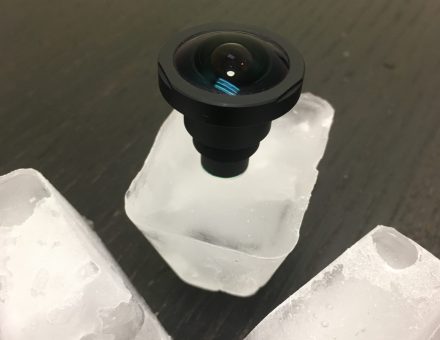At Sunex, we get the above question frequently, but the answer is not straightforward. Specifying an operating temperature range for a lens can be tricky, because generally speaking, there is no point within a lens’ physically survivable temp range that it will suddenly “fail.”
Since the index of refraction is a function of temperature, nearly all lenses experience some performance degradation over temperature, yet could still reasonably be considered “operational” well beyond their specified nominal temperature range. Therefore, in order to specify an operating range that has any practical application, one must first define failure criteria. This is often a minimum MTF [over the temperature range], but can also be a physical value, such as a focal shift in µm. One can also specify the Operational Temperature range as a % of the nominal performance, for example, when the lens loses >10% of its nominal (ambient) MTF. All of these approaches are related to the focal plane shift of the lens over temperature and hence the “best focus” location and by extension its impact on MTF. However, Operational Temperature can also be defined by other first-order specifications altogether, such as FOV or Magnification, since these are tied to the index of refraction over temperature and therefore the resulting power of the lens. For general purposes, however, it is typically safe to assume that glass lenses will perform within specification from -20-60C and hybrid or plastic lenses from 0-40C when focused at 20C nominally, but this is a conservative rule of thumb, and the lenses will likely perform well by most measures, well beyond these limits.
To throw another wrench into the original question of “what is the operating temperature range,” and to take the above one step further, one needs to remember that the lens is not acting by itself. The operating temperature of the lens is oftentimes not even the most relevant factor in the thermal performance of the imaging chain. The way the lens is mounted and its relationship to the sensor’s image plane is often more critical than the thermal performance of the lens itself. Some lenses can be very stable, yet perform poorly in a system design with high effective CTE. Other lenses can have high [effective] CTE and perform extremely well over extreme temperature ranges when proper system design is utilized.
While this post does not go into the details and strategies of the athermalized lens and system design, it is important to understand that the thermal performance of the lens can only be properly viewed in the context of the overall system design and especially the lens and sensor mount design of the camera. So when searching for a lens, think about what criteria are important in your application, and what temperatures your use case will actually encounter. With this information, Sunex will be able to help you not only pick the best lens option but also provide some insight on what type of mounting and focusing strategies may work best.
Please view the following webinar for more details on how to achieve stable image quality over a wide temperature range:


